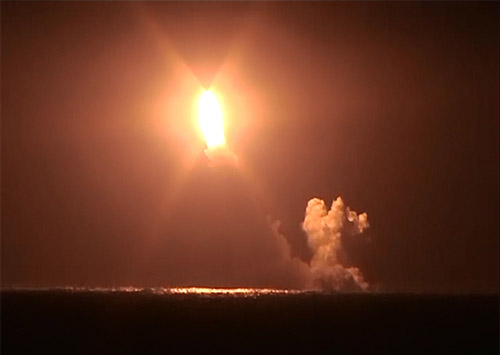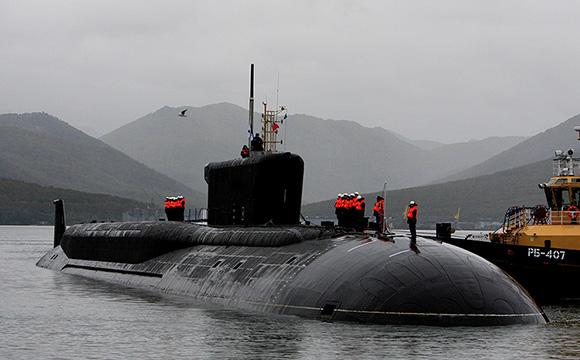The strategic class submarines Borei, Yuri Dolgoruky e Vladimir Monomakh in service with the Northern Fleet, they were assigned to the permanent alert force. This was announced by Admiral Nikolai Yevmenov, commander of the Northern Fleet. Yevmenov added that the strategic fleet submarines regularly carry out patrolling missions in the Arctic and on the globe.
Fourth generation class submarines Borei will involve the backbone of the strategic nuclear deterrent of the Russian Navy. They will replace the class submarines Typhoon, Delta-3 e Delta-4. The first three Borei, Project 955, I am the K-535 Yury Dolgoruky who joined the Northern Fleet in January of the 2013, followed by the K-550 Aleksandr Nevskij (photo) at the end of December of the same year. The Nevsky is in service with the Pacific Fleet. The K-551Vladimir Monomakh entered service in the 2014. Fourth Borei, the Knyaz Vladimir, Progetto 955 / A, is under construction since July 2012 at the Sevmash shipyard, in northern Russia. The construction of the fifth nuclear-powered submarine "Knyaz Oleg" began in July of the 2014.
Work on the "Generalissimus Suvorov" began in December last year. A few weeks later, even the seventh Borei, baptized Imperator Aleksandr III, entered production at the Severodvinsk construction site. The last of the class Knyaz Pozharsky, should be launched by next December. Despite the rumors, there are no confirmations on two other possible submarines.
Within the 2020, the Russian Navy plans to operate on a total of eight class ballistic submarines Borei: three 955 and five 955-A. Considering the structural changes, it would not be a mistake to define the 955-A submarines as a class Borei-II. Designed on a hydrodynamic hull designed to reduce broadband noise emissions, the class Borei it is the first in the Russian navy to use propulsion pump-jet. Submarines Borei they are long 170 meters, with a diameter of 13 meters and a maximum immersion speed of 46 kilometers per hour conferred by the OK-650 nuclear reactor. The operational depth is attested on the 380 meters (maximum test occurred at 450 meters).
Each Borei should carry from sixteen to twenty missiles "Bulava" (only for 955A), each of which has from six to ten Mirv warheads. The Russians are optimistic about the missiles Bulava and class submarines Borei, which is entrusted with nuclear deterrence at least until the 2050 (after the abandonment of the studies on the R-39UTTH missile Bark). The test launches will end within the year. The missiles will be launched from the submarines of the Northern and Pacific Fleet.
 The "Bulava" three-stage missile, codenamed Nato SS-N-30 Mace, is the naval version of the most advanced Russian ballistic missile, the SS-27 Topol-M. It can also be launched in motion. It carries up to 10 Mirv warheads, can hit targets up to eight thousand kilometers away and is designed to exclusively equip class nuclear submarines Borei (the changes on the Typhoons were deemed too expensive).
The "Bulava" three-stage missile, codenamed Nato SS-N-30 Mace, is the naval version of the most advanced Russian ballistic missile, the SS-27 Topol-M. It can also be launched in motion. It carries up to 10 Mirv warheads, can hit targets up to eight thousand kilometers away and is designed to exclusively equip class nuclear submarines Borei (the changes on the Typhoons were deemed too expensive).
Despite numerous failures due to manufacturing defects, the Russian army claims that there is no alternative to Bulava. Due to the failure during the tests of the new intercontinental missiles Bulava, the Borei they are not yet able to carry out their primary task, namely nuclear deterrence. Each Bulava missile (along 12,1 meters, 2,1 meter diameter and heavy 36,8 tons) is armed with 6-10 thermonuclear warheads for 96-196 submarine tested. The possible coverage of sensitive targets, considering the range of eight thousand kilometers, could be the Barents Sea and the Sea of Okhotsk. If the Russians launched from these areas, they could hit any point in the continental United States.
The first Borei, the "Yury Dolgoruky" K535, cost the Russian government slightly less than 720 million dollars, including research and development chapters. Within the next three months, the Russians should carry out a multiple launch of intercontinental ballistic missiles. The tests are part of the (additional) maneuvers planned by the Russian Admiralty for the entry into service of the strategic deterrent weapon system. It is confirmed that to launch the missiles Bulava will be the class submarines Borei Yuri Dolgoruky e Vladimir Monomakh. Multiple launches will have to demonstrate the reliability of submarines, which will have to be able to fire on the move, at a depth of 50 meters and with rough seas. The Russians, however, hold a particular record: that of having thrown an entire spear of ballistic missiles (unarmed) from a submarine.
The August 6 of the 1991 the class submarine Delta IV K-407 Novomoskovsk, has entered history for having launched, with an interval of a few seconds, 16 ballistic missiles (RSM-54) with a total weight of almost 700 tons. The "Behemoth-2" operation has demonstrated the ability to launch, in the event of a possible nuclear scenario, the entire salvage of strategic missiles from the depths of the sea, hence from a position of safety. The US record belongs to the Ohio-class nuclear submarine leader, which launched four missiles Trident-2.
It is not yet clear how many Bulava the Russians will launch, but after the delays and problems with the development of the new missiles, Putin could order a total launch to sanction the entry into service of the weapon system and the consequent beginning of strategic patrols.
(photo: MoD Russian Federation)












